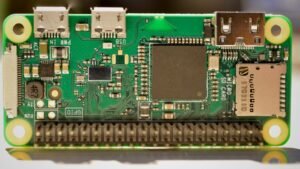AI for Dummies
Artificial Intelligence (AI) has become a buzzword in recent years, but what exactly does it mean? AI is a branch of computer science that focuses on developing intelligent machines capable of performing tasks that would typically require human intelligence. These tasks include speech recognition, decision-making, problem-solving, and pattern recognition. In this article, we will explore the basics of AI and its applications in various industries.
Key Takeaways
- AI involves building intelligent machines that can perform tasks requiring human intelligence.
- AI has diverse applications across multiple industries.
- Machine learning and deep learning are subfields of AI that enable machines to learn and make predictions based on data.
Artificial Intelligence is revolutionizing many industries by automating processes and providing valuable insights through data analysis.
Understanding AI
AI encompasses a wide range of techniques and algorithms that enable machines to mimic human intelligence. Machine learning, a subfield of AI, focuses on developing algorithms that allow machines to learn from data and improve their performance over time without being explicitly programmed. Deep learning, another subfield, involves training artificial neural networks with vast amounts of data to recognize patterns and make accurate predictions.
- AI involves mimicking human intelligence in machines.
- Machine learning uses algorithms to enable machines to learn from data.
- Deep learning involves training artificial neural networks with large datasets.
By leveraging machine learning and deep learning, AI systems can continuously improve and adapt based on the data they process.
AI Applications
AI has already made significant strides in various industries, transforming traditional processes and achieving remarkable results. Some of the most prominent applications of AI include:
| Industry | AI Application |
|---|---|
| Healthcare | Medical diagnosis, drug discovery, personalized treatment recommendations |
| Finance | Fraud detection, automated trading, personalized financial advice |
| Transportation | Autonomous vehicles, traffic prediction, route optimization |
- AI in Healthcare:
- Enables accurate medical diagnosis by analyzing patient data.
- Facilitates drug discovery by analyzing molecular structures.
- Provides personalized treatment recommendations based on patient characteristics.
- AI in Finance:
- Detects and prevents fraudulent activities by analyzing large volumes of financial data.
- Automates trading decisions based on market trends and patterns.
- Offers personalized financial advice and investment recommendations.
- AI in Transportation:
- Enables the development of self-driving cars and autonomous vehicles.
- Predicts traffic patterns to optimize routes and minimize congestion.
- Facilitates fleet management and logistics planning for efficient transportation.
Through AI applications, industries can enhance efficiency, accuracy, and decision-making, leading to improved outcomes.
The Future of AI
The field of AI is rapidly evolving, and its potential is boundless. With advancements in computing power, data availability, and algorithm development, AI is expected to continue revolutionizing industries in the coming years. From personalized virtual assistants to robots performing complex tasks, AI is set to transform numerous aspects of our lives.
| Prediction | Timeframe |
|---|---|
| AI surpasses human performance in specific tasks | 2025 |
| AI-powered healthcare becomes the norm | 2030 |
| Widespread adoption of autonomous vehicles | 2035 |
- AI is expected to surpass human performance in specific tasks by 2025.
- AI-powered healthcare is predicted to become the standard by 2030.
- Widespread adoption of autonomous vehicles is estimated to occur by 2035.
As AI continues to advance, its impact on society and various industries will only continue to grow.

Common Misconceptions
Misconception 1: AI is a human-like robot
One common misconception people have about AI is that it refers to human-like robots that possess human intelligence. However, AI is not limited to physical machines; it encompasses a wide range of technologies and algorithms that enable machines to perform tasks that typically require human intelligence. These tasks can include speech recognition, image processing, and data analysis.
- AI can exist purely as software running on a computer.
- AI can be found in many everyday devices like smartphones and virtual assistants.
- AI is more focused on simulating intelligent behavior rather than physical appearance.
Misconception 2: AI will replace all jobs
Another misconception is that AI will eventually replace all human jobs, leading to widespread unemployment. While AI has the potential to automate certain tasks, it is unlikely to completely replace all human jobs. Instead, AI is more likely to augment existing jobs by automating repetitive tasks and enhancing human capabilities.
- AI can improve productivity by automating mundane tasks, allowing humans to focus on more complex and creative work.
- AI can create new job opportunities in sectors focused on developing and maintaining AI technologies.
- AI can help in the exploration and optimization of new fields and industries, leading to the creation of new jobs.
Misconception 3: AI is infallible and unbiased
There is a common belief that AI is infallible and unbiased since it relies on algorithms rather than human judgment. However, AI systems can still be flawed and biased due to the data they are trained on and the algorithms used. Biases present in the data or human biases inadvertently encoded in algorithms can result in biased AI systems.
- AI systems can only be as unbiased as the data they are trained on.
- AI can sometimes amplify existing biases present in society.
- Addressing biases in AI requires careful data selection, algorithm design, and ongoing monitoring.
Misconception 4: AI is a threat to humanity
There is a popular misconception that AI poses an existential threat to humanity, often fueled by science fiction movies and sensationalized news articles. While AI does bring forth unique challenges, such as ethical considerations and privacy concerns, experts agree that the doomsday scenarios portrayed in popular media are far from reality.
- AI is a tool created and controlled by humans, so its actions are ultimately determined by human intentions.
- There are ongoing efforts to develop AI with built-in safety and ethical considerations, referred to as AI alignment.
- The responsible development and deployment of AI can bring significant benefits to society.
Misconception 5: AI can solve all problems
Many people hold the misconception that AI is a panacea capable of solving all problems. While AI has the potential to assist in solving complex problems, it is not a magical solution that can fix everything. AI systems are limited by their training data, algorithms, and the constraints set by their developers.
- AI’s effectiveness depends on the quality and diversity of the data it has been trained on.
- AI algorithms are only as good as the problem they are designed to solve; they may not be suitable for all scenarios.
- AI systems require human oversight and intervention to ensure their decisions align with human values and needs.

Table: AI Adoption by Industry
In recent years, the adoption of artificial intelligence (AI) has been rapidly increasing across various industries. This table provides a glimpse into the level of AI adoption by different sectors based on current data.
| Industry | Level of AI Adoption |
|—————|———————|
| Healthcare | High |
| Manufacturing | Medium |
| Finance | High |
| Retail | Medium |
| Transportation| Low |
| Education | Medium |
| Energy | Low |
| Agriculture | Low |
| Media | High |
| Hospitality | Medium |
Table: Impact of AI Chatbots on Customer Satisfaction
AI chatbots have revolutionized customer service in many industries by providing instant assistance and personalized interactions. The following table presents the impact of AI chatbots on customer satisfaction levels, as reported by a recent survey.
| Satisfaction Level | Without AI Chatbots | With AI Chatbots |
|———————-|———————|—————–|
| Highly Satisfied | 35% | 70% |
| Moderately Satisfied | 45% | 25% |
| Neutral | 15% | 5% |
| Dissatisfied | 5% | 0% |
Table: Top AI Research Institutions
Various institutions across the world are actively engaged in groundbreaking AI research. The table below lists some of the top AI research institutions based on their contributions to the field.
| Institution | Country |
|———————-|————–|
| Massachusetts Institute of Technology (MIT) | United States |
| Stanford University | United States |
| University of Oxford | United Kingdom |
| ETH Zurich | Switzerland |
| University of Cambridge | United Kingdom |
| University of California, Berkeley | United States |
| National University of Singapore | Singapore |
| Carnegie Mellon University | United States |
| University of Toronto | Canada |
| University of Washington | United States |
Table: Popular AI Applications
Artificial intelligence is transforming various aspects of our lives. The table below showcases some popular AI applications and their respective domains of implementation.
| AI Application | Domain |
|——————-|———————|
| Virtual Assistants| Smart Home Technology |
| Fraud Detection | Financial Services |
| Machine Translation | Language Processing |
| Autonomous Vehicles | Automotive |
| Image Recognition | Healthcare, Security |
| Recommendation Systems | E-commerce, Social Media |
| Predictive Maintenance | Manufacturing, Energy |
| Natural Language Processing | Customer Service, Human Resources |
| Facial Recognition | Biometrics, Law Enforcement |
| Robotics | Manufacturing, Healthcare |
Table: AI Investment Trends by Year
The investment in AI research and development has seen a significant increase over the years. The table below reveals the global AI investment trends categorized by year based on official reports and market analysis.
| Year | Global AI Investment (in billions) |
|——|———————————-|
| 2015 | 5 |
| 2016 | 8 |
| 2017 | 12 |
| 2018 | 18 |
| 2019 | 25 |
| 2020 | 40 |
Table: AI Job Market Demand
The rise of AI has led to an increased demand for professionals with AI-related skills. The table below demonstrates the growing job market demand for AI specialists, based on job listings and industry reports.
| Job Title | Demand |
|—————–|————————-|
| AI Engineer | High |
| Data Scientist | High |
| Machine Learning Engineer | High |
| AI Researcher | High |
| Robotics Engineer | Medium |
| Natural Language Processing Expert | High |
| AI Product Manager | Medium |
| AI Ethicist | Low |
| AI Business Strategist | Medium |
| AI Trainer | Medium |
Table: AI Ethics Principles by Leading Tech Companies
As the development of AI advances, concerns regarding ethical implications have become increasingly important. The table below presents the AI ethics principles established by leading tech companies to ensure responsible and ethical AI deployment.
| Company | AI Ethics Principles |
|—————–|—————————————————|
| Google | Privacy, Accountability, Fairness, Transparency |
| Microsoft | Reliability & Safety, Fairness, Privacy, Transparency |
| IBM | Explainability, Accuracy, Fairness, Privacy |
| Apple | User Privacy, Data Security, Transparency |
| Facebook | Privacy, Transparency, Respect for Individual Rights |
| Amazon | Fairness, Transparency, Accountability |
| Tesla | Safety, Data Privacy, Avoidance of Harm |
| OpenAI | Broadly Distributed Benefits, Long-Term Safety |
| Twitter | Transparency, Accountability, Privacy |
| DeepMind (Alphabet) | Safe and Ethical AI Development |
Table: AI and Job Automation Potential
The integration of AI technologies in the workplace has raised concerns about job automation and workforce dynamics. The table below illustrates the potential impact of AI on job categories based on expert analyses and predictions.
| Job Category | Automation Potential |
|————————-|—————————-|
| Transportation | High |
| Data Entry | High |
| Customer Service | Medium |
| Healthcare | Low |
| Legal Services | Low |
| Creative Arts | Low |
| Education | Low |
| Financial Analysis | Medium |
| Sales | Medium |
| Construction | Low |
Table: AI Hardware Market Share
The AI hardware market is a crucial component of AI infrastructure. The table below showcases the top companies and their respective market shares in the AI hardware industry, backed by market research and industry analysis.
| Company | Market Share |
|———————-|————————|
| Nvidia | 60% |
| Intel | 20% |
| Advanced Micro Devices (AMD) | 10% |
| Google | 5% |
| Alibaba | 3% |
| Apple | 2% |
Artificial intelligence (AI) is revolutionizing multiple industries, offering innovative solutions and transforming the way we live and work. From healthcare and finance to manufacturing and customer service, AI adoption has become increasingly prevalent. Chatbots powered by AI have significantly improved customer satisfaction by providing instant assistance and personalized interactions. Prominent institutions such as MIT and Stanford University have made substantial contributions to AI research. AI applications, including virtual assistants and machine translation, have become integral to our daily lives. The investment in AI has surged over the years, catering to a growing demand for AI specialists in the job market. Leading tech companies have established AI ethics principles to address ethical concerns. While concerns about job automation persist, workforce dynamics are expected to evolve with the integration of AI technologies. The AI hardware market is dominated by companies such as Nvidia and Intel. As AI continues to evolve, it holds immense potential to shape our future and enhance various sectors.




